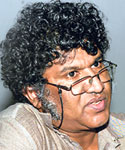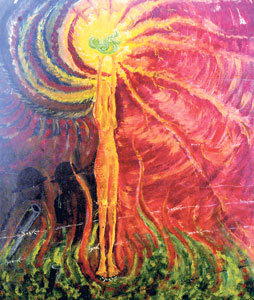For four days only – August 28 till 31 (10 a.m.- 7 p.m.) – the Lionel Wendt Gallery and the Harold Pieris Gallery are hosting an exhibition that aims to distil the artistic response to 26 years of civil war from across Sri Lanka’s social spectrum. The plainly titled ‘Visual Responses During the War: Selected Works of Artists’ features painting, drawing, sculpture, installation, photography and video from 22 artists who together represent the island in miniature.
 |
| Curator Chandraguptha Thenuwara. Pix by Saman Kariyawasam |
Tamil artists Kiko, T. Shanathanan, G. R. Constantine, Vaidehi Rajasingam and Kamala Vasuki are exhibited alongside Sinhalese artists such as Jagath Weerasinghe and Muslims such as Muhanned Cader. Together they conjure a shared experience of conflict and suffering, and warn against the toxins of ethnic and religious chauvinism.
Chandraguptha Thenuwara, the curator of the exhibition, and a painter whose work also features on its walls, described to the Sunday Times the process of introspection and re-evaluation that the war forced upon Sri Lankan artists – something like a call to artistic responsibility, he recounted. Conventional notions of beauty and traditional methods of representation, such as the flat painted rectangle, were no longer felt to be sufficient in communicating the contradictions and cruelties of a society in perpetual war. A new artistic language had to emerge, with new formats and mediums of expression, to surprise viewers and shock them into a full consciousness of their present condition, and – most importantly – of how the division and mutual hatred had come to pass. “We were seeing things,” Thenuwara said, “but we were not looking.”
Thenuwara went on to describe the delayed response of Sri Lankan artists to the transformed realities of war. Although the conflict is commonly said to have begun in 1983, with the Tamil pogroms, it was not until the early nineties that the ‘new’ art began to appear, grappling with it head-on. Indeed, there is nothing in the exhibition that predates the nineties. New formats took precedence, such as multi-media installations, sculpture-painting hybrids, and video and digital art. Traditional Sri Lankan motifs were reworked; for instance, the exhibition contains a painting by Kiko of what at first appears to be a conventional image of Ganesh – only, on closer inspection, the elephant god is revealed to have striped tiger skin and to be wielding axes from multiple arms, expressing Kiko’s disquiet that her Tamil Hindu identity was being hijacked and distorted by Tamil militant groups for their own violent cause.
 |
Of course, despite the growing conflict, the early nineties was also the era that conceptual, installation art became a big seller on the international art market – something that gained particular fame and notoriety with the Brit Art movement characterized by Damien Hurst and Tracey Emin – and its flowering in Sri Lanka at the time can perhaps be attributed as much to this as to the changed social realities of ethnic conflict. Yet, there can be no doubt that it captured the shared suffering of civil war in a unique and often haunting way.
The exhibition contains an innovative piece of ‘book art’ from Kingsley Gunatillake: on an existing book that surveys the ‘culture’ of Sri Lanka, Kingsley has scrawled in pen the wording of the 1972 constitution, a resonate legal gesture that embodied the hope at the time for an end to Tamil grievances with an equitable settlement of rights – only, on either side of the open book, the respective armies of the government and the LTTE have burst through the pages in toy soldier form, firing at each other across the book’s spine. The violence committed against the cultural fabric of Sri Lanka is hinted at in the book’s ruptured pages, but the position of the two miniature sculptural armies on either side of the same book affirms the essential unity of the island, and the absurdity of the war itself.
The exhibition also sees the return of Anoma Wijewardene’s multi-media installation, ‘Quest’, first exhibited in Colombo’s National Art Gallery in 2006 and exhibited here in a pared-down format. Anoma, who confesses to beginning her projects with no clear idea of their outcome, travelled with a collection of white paper doves from Jaffna to Matara to Colombo in the immediate aftermath of the 2002 ceasefire agreement, which at the time signalled a pause for rehabilitation and, crucially, reflection on the harm and suffering committed and felt on both sides. Shocked by the devastation she saw, she begun taking photographs which she later manipulated on a computer. The project evolved, however, when she began documenting, in a similar fashion, the aftermath of the 2004 Tsunami, which in a single day killed 30,000, half the number of those killed in two whole decades of civil war. This added dimension underlined, she felt, the message of her work: the common experience of suffering as a universal evil, which begs nothing less than a universal response to alleviate.
‘Quest’ took the eventual form of a series of digital images set alongside a selection of quotations from authors, philosophers, politicians and ordinary Sri Lankans, with a dialogue to be drawn between them. The images and quotations were also synthesised in a 36 minute film projected on three different screens in one room of the gallery, each in one of the three principal languages of Sri Lanka: Sinhala, Tamil and English. ‘Visual Responses to the War’ will display only the English version, which, as the Sunday Times can enthusiastically attest, retains the original work’s hypnotic visual spell and urgent message of peace and moral regeneration. “How do we build up from these ashes of devastation…how do we get to peace from here?” the artist asks. “For me, the answer begins in art.” |



